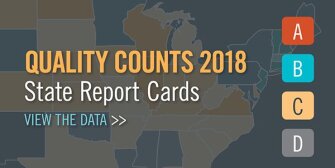Editor’s note: The state scores and grades referenced in this article have since been updated to reflect the most current results from federal reading and math tests. This article does not represent the latest scores and grades given states in Quality Counts 2018, which are available here.
As a new presidential administration nears the close of its first year in office and educators across the country grapple with the challenges and opportunities in implementing the Every Student Succeeds Act, the nation’s educational performance earns a grade of C from Quality Counts 2018, the 22nd annual report card issued by the Education Week Research Center.
The nation’s score of 74.5 is about the same as last year, when it posted a 74.2, also a C grade—continuing years of flat performance noted in the annual report, which weighs a host of academic, fiscal, and socioeconomic factors.
Looking deeper, this year’s score reflects a mix of strengths and weaknesses, along with substantial disparities between high- and low-performing states. Nationally, high school graduation and postsecondary participation rates are up. But schools continue to struggle with wide achievement and funding gaps.

Massachusetts finishes first in the nation for the fourth straight year, with a B-plus and a score of 86.8. Four states with grades of B are its closest competitors: New Jersey (85.9), Vermont (84.1), New Hampshire (83.7), and Connecticut (83.0).
At the other end of the spectrum, Nevada receives the nation’s lowest score (65.0), a D. New Mexico also gets a D, with a score of 66.2.
Pacesetters and Standouts
The grades for the nation and the states in Quality Counts are based on results across 39 distinct indicators capturing the overall environment contributing to a young person’s success, school funding, and student achievement.
The overall A-F letter grades reflect the average of numerical scores on a traditional 100-point scale for three custom indices developed by the Research Center:
- The Chance-for-Success Index uses a cradle-to-career perspective to examine the role of education in promoting positive outcomes throughout an individual’s lifetime.
- The school finance analysis evaluates spending on education and equity in funding across districts within a state.
- The K-12 Achievement Index, last updated in 2016, scores states on current academic performance, change over time, and poverty-based gaps.
For the 11th year in a row, the nation earns a C-plus on the Chance-for-Success Index. Perennial stalwarts, Massachusetts and New Hampshire, lead the pack in this category with grades of A-minus and scores of 91.7 and 90.7, respectively. New Mexico (67.0) and Nevada (67.8) score lowest with D-plus grades.
As it has for nearly a decade, the nation receives a C for school finance, but its numeric score inched up by a half point since last year. Wyoming, consistently a star in this category, is again at the top of the rankings and finishes with the only A-minus (91.4). Idaho ranks last with a score of 59.7 and a D-minus. The finance indicators in Quality Counts 2018 are based on data from 2015, the most recent available from the federal government.
School Finance Report & Rankings:
See how much gets spent state by state, and how fairly it’s divvied up.
Results for the K-12 Achievement Index, which make up one-third of this year’s overall grade, rely largely on National Assessment of Educational Progress scores. Because of a delay in the release of new NAEP scores, results for the index remain unchanged from Quality Counts 2016. High school graduation rates and Advanced Placement exam scores make up additional components of the analysis.
The nation earned a C-minus for K-12 Achievement, with a score of 71.0. Massachusetts (85.2) posted the highest score, receiving the sole B. Mississippi (60.0) and New Mexico (61.8) finished with the nation’s lowest marks at D-minus.
A Closer Look at State Performance
In 1997, the editors of the first Quality Counts wrote that the state report card was being published to help Americans hold “their representatives—and themselves—accountable for the quality of their public schools.” If anything has become even more clear in recent years, it’s that the onus for driving student achievement will be on state-level policymakers. Since the new latitude that ESSA gives state leaders to develop customized accountability systems could either help to narrow disparities across states or widen them, monitoring state performance remains critical.
This year’s Quality Counts results indicate that many states fare well in some areas, but struggle in others. The majority of states (31) post mediocre grades between C-minus and C-plus, in line with the nation as a whole.

The states with the best overall grades typically perform well across many of the metrics, but especially on indicators related to educational foundations in early childhood. Those factors help children get off to a good start and to enter the pre-K-12 system ready to learn. For instance, the overall top-scoring states, Massachusetts and New Jersey, rank in the top 10 for parent education.
Research suggests that children facing fewer risk factors, such as living in poverty, are more likely to succeed academically. States with the top overall grades generally have higher family income levels and are often nestled in more affluent and prosperous regions of the country, most commonly the Northeast and Mid-Atlantic. New Hampshire and Massachusetts, for example, rank first and second in family income.
The school finance analysis examines education spending and equity in the distribution of funding across the districts within each state. The states with the highest overall grades on the report card tend to have relatively high spending—but they don’t always rank near the top in equity. The Quality Counts analysis finds wide disparities in funding across districts in some generally high-performing states. Vermont, for example, is second for spending and 48th for equity. Still, per-pupil expenditures and other spending metrics demonstrate that these states devote substantial resources to education.
While early foundations in childhood and income-related metrics play a role in the grading, academic indicators make up the largest component. Leading states tend to fare well with respect to NAEP reading and math scores, along with high school graduation rates. Massachusetts and New Hampshire—both in the top five states overall in Quality Counts—lead the nation in 4th grade reading on NAEP.
Postsecondary education can open doors allowing young people to access career opportunities and states to enhance their economic competitiveness. Moving students into postsecondary pathways is a critical goal of K-12 education systems. Leading states are often near the top of rankings for postsecondary participation. Massachusetts, New Jersey, and New York all rank in the top 10 states this year and were among the top five for postsecondary participation.
In states that struggle in the grading, schools and students often face stumbling blocks in early-childhood education, higher poverty, lower academic achievement, and reduced opportunities for postsecondary schooling. These states also often have lower spending on K-12 schools.
Progress in a Handful of States
Four states—California, Mississippi, North Dakota, and Oregon—saw gains of a point or more in their overall grades between 2017 and 2018, a small but meaningful increase in the context of this year’s report.
California’s overall grade improved the most of any state (1.3 points). The jump in its overall score was largely driven by a gain in the school finance category, specifically gains in per-pupil spending (as adjusted for regional cost differences) and the percent of students in districts spending at or above the U.S. average.
Mississippi boosted its results across a range of metrics, including family income, preschool enrollment, and high school graduation. By contrast, North Dakota lost some ground on family income and preschool enrollment but gained substantially in school finance. Oregon made strides in postsecondary participation and annual income, among other areas.
It might take a crystal ball to accurately forecast the precise mix of conditions and programs that each state would seek to promote changes. But education policies and shifting economic outcomes can influence results on the scorecard. As the editors of the first Quality Counts wrote more than two decades ago—when the nation also received a grade of C overall—public education systems in the 50 states “cannot be transformed quickly, but they can be significantly improved.”







